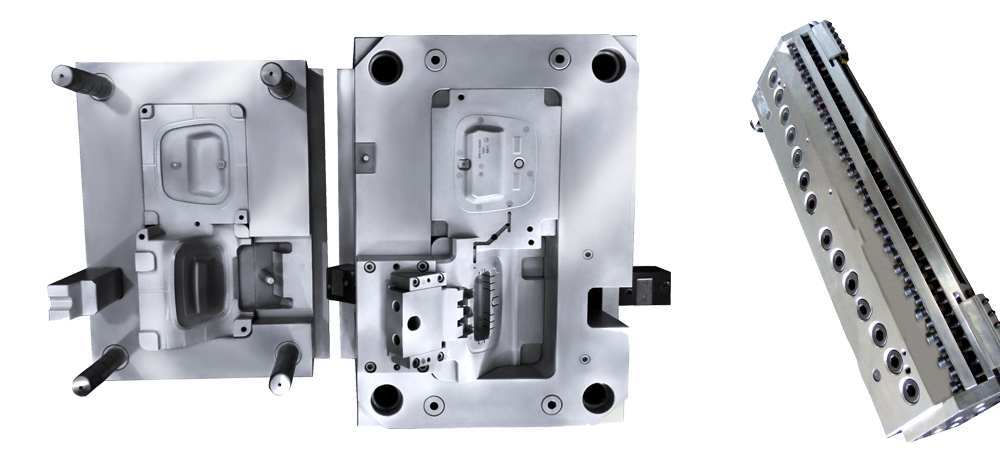hardware mould group
The tools and products we use in our daily production and life are as large as the base of the machine tool.
The fuselage shell, as small as an embryo screw, button and the shell of various household appliances, all have a close relationship with the mold. The shape of the mold determines the shape of these products, and the quality and precision of the mold determines the quality of these products. Because of the different materials, appearance, specifications and uses of various products, the mold is divided into casting molds, forging dies, die-casting dies, stamping dies and other non-plastic molds, as well as plastic molds.
hardware mould group
Process nature
(1) Blanking die The material is separated along a closed or open contour. Such as blanking die, punching die, cutting die, slit die, trimming die, cutting die and so on.
(2) Bending mold A mold for bending a sheet blank or other blank along a straight line (curved line) to obtain a workpiece of a certain angle and shape.
(3) The drawing die is a die in which the blank of the sheet is made into an open hollow member, or the hollow member is further changed in shape and size.
(4) Forming die A mold in which a blank or a semi-finished workpiece is directly copied and formed in the shape of a convex or concave die, and the material itself produces only a partial plastic deformation. Such as bulging die, shrinking die, flaring die, undulating forming die, flanging die, shaping die and the like.
Process combination
(1) Single-step mold In the one stroke of the press, only one mold of the stamping process is completed.
(2) Composite mold There is only one station, in the same position of the press, in the same station
hardware mould group
A mold that performs two or more stamping processes simultaneously.
(3) Progressive die (also called continuous die) There are two or more stations in the feeding direction of the blank, and two or two successively in different positions in the one stroke of the press The mold of the stamping process above the road.
Continuous die (stage progressive die), the press adopts strip stamping raw material in one press stroke, and completes the cold stamping die of multiple stamping processes at the same time with several different stations on one pair of molds. The belt moves once at a fixed distance until the product is completed.
During the stamping process, the material strip always moves in one direction; the inner strip of the mold is cut into two or more directions and called the progressive die; the feeding of the strip in the mold is called automatic continuous die; A stamping die with different processes on a stamping production chain uses robots or other automated facilities to move the workpiece by stamping or part moving. The rated die is called a multi-station die.
Mold material
The most important factors of mold materials are heat strength and thermal stability. Common mold materials: working temperature, forming materials, mold materials.
<300°C zinc alloy Cr12, Cr12MoV, GCr15, T8, T10
300~500°C Aluminum alloy, copper alloy 5CrMnMo, 3Cr2W8, 9CrSi, W18Cr4V, 5CrNiMo, W6Mo5Cr4V2, M2
500~800°C Aluminum alloy, copper alloy, steel titanium GH130, GH33, GH37
800~1000°C Titanium alloy, steel, stainless steel, nickel alloy K3, K5, K17, K19, GH99, IN100, ЖC-6NX88, MAR-M200, TRW-NASA, WA
>1000°C nickel alloy copper base alloy
hardware mould group
One of the key components in the mold assembly is the mold spring.
The mold springs include: Japanese standard mold springs, German standard mold springs, springs, and polyurethane springs. Usually, the mold springs refer to rectangular mold springs.
Mold springs are widely used in stamping dies, metal die-casting dies, plastic molds, and other elastic motion precision machinery and automobiles.
The mold spring material is generally selected from chrome alloy steel. The chrome alloy spring steel has the characteristics of high temperature resistance, high rigidity and long service life.
The rectangular mold spring has the characteristics of small volume, good elasticity, high rigidity, high precision, rectangular material, and surface color separation coating (plating) to distinguish different load and beautiful appearance.
hardware mould group
(1). Conduct research on the direction of materials (product materials, mold materials).
(2). Concave mode gap size.
(3). The position and quantity of the pilot pin are sufficient.
Hardware mould
(4). Whether to consider the scrapping of the scrap, and whether the delivery of the mold is smooth.
(5). Whether the monitor, waste rebound sensor is designed.
(6). The positioning plate and the floating pin are selected appropriately.
(7). Whether the number, size and position of the bolts (including the discharge bolts) are properly selected.
(8). Consider the punching force and choose the punch.
